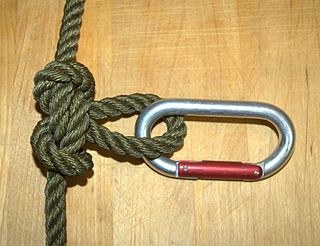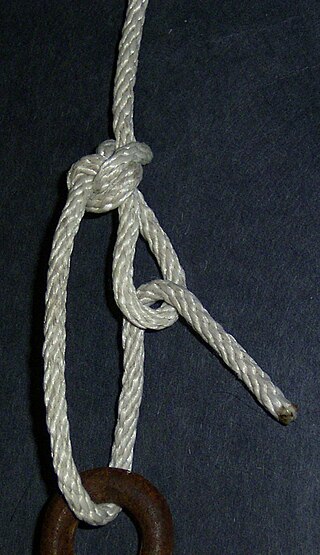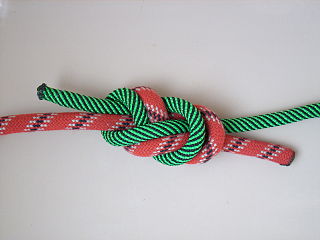
The butterfly loop, also known as lineman's loop, butterfly knot, alpine butterfly knot and lineman's rider, is a knot used to form a fixed loop in the middle of a rope. Tied in the bight, it can be made in a rope without access to either of the ends; this is a distinct advantage when working with long climbing ropes. The butterfly loop is an excellent mid-line rigging knot; it handles multi-directional loading well and has a symmetrical shape that makes it easy to inspect. In a climbing context it is also useful for traverse lines, some anchors, shortening rope slings, and for isolating damaged sections of rope.

The constrictor knot is one of the most effective binding knots. Simple and secure, it is a harsh knot that can be difficult or impossible to untie once tightened. It is made similarly to a clove hitch but with one end passed under the other, forming an overhand knot under a riding turn. The double constrictor knot is an even more robust variation that features two riding turns.

The trucker's hitch is a compound knot commonly used for securing loads on trucks or trailers. The general arrangement, using loops and turns in the rope itself to form a crude block and tackle, has long been used to tension lines and is known by multiple names. Knot author Geoffrey Budworth claims the knot can be traced back to the days when carters and hawkers used horse-drawn conveyances to move their wares from place to place.

The figure-eight knot or figure-of-eight knot is a type of stopper knot. It is very important in both sailing and rock climbing as a method of stopping ropes from running out of retaining devices. Like the overhand knot, which will jam under strain, often requiring the rope to be cut, the figure-eight will also jam, but is usually more easily undone than the overhand knot.
The figure-eight or figure-of-eight knot is also called the Flemish knot. The name figure-of-eight knot appears in Lever's Sheet Anchor; or, a Key to Rigging. The word "of" is nowadays usually omitted. The knot is the sailor's common single-strand stopper knot and is tied in the ends of tackle falls and running rigging, unless the latter is fitted with monkey's tails. It is used about ship wherever a temporary stopper knot is required. The figure-eight is much easier to untie than the overhand, it does not have the same tendency to jam and so injure the fiber, and is larger, stronger, and equally secure.

Figure-eight loop is a type of knot created by a loop on the bight. It is used in climbing and caving.
The Flemish loop or figure-eight loop is perhaps stronger than the loop knot. Neither of these knots is used at sea, as they are hard to untie. In hooking a tackle to any of the loops, if the loop is long enough it is better to arrange the rope as a cat's paw.

A double bowline is a type of loop knot. Instead of the single turn of the regular bowline, the double bowline uses a round turn. This forms a more secure loop than a standard bowline.

A climbing harness is a piece of equipment that allows a climber to tie in to the safety of a rope. It is used in rock and ice climbing, abseiling, and lowering; this is in contrast to other activities requiring ropes for access or safety such as industrial rope work, construction, and rescue and recovery, which use safety harnesses instead.

A becket hitch, including the double becket or figure-of-eight becket hitch, is any hitch that is made on an eye loop, i.e. on a becket. A becket hitch has the same structure as the sheet bend, which joins, or "bends", the ends of two ropes together. The becket hitch, in contrast, fixes a rope to a closed eye or hook. In this instance, a becket means the eye or hook of a pulley block, an eye in the end of a rope, or a rope handle on a sailor's sea chest.

The offset overhand bend is a knot used to join two ropes together end-to-end. It is formed by holding two rope ends next to each other and tying an overhand knot in them as if they were a single line. Due to its common use in several fields, this bend has become known by many names, such as thumb knot, openhand knot, one-sided overhand knot or flat overhand bend (FOB), though the terms "one-sided" and "flat" are considered incorrect.

The bowline on a bight is a knot which makes a pair of fixed-size loops in the middle of a rope. Its advantage is that it is reasonably easy to untie after being exposed to load. It is one of the two tie-in knots that are being taught by the German Alpine Club (DAV), generally being considered secure.

The figure-of-nine loop is a type of knot to form a fixed loop in a rope. Tied in the bight, it is made similarly to a figure-of-eight loop but with an extra half-turn before finishing the knot.

The Flemish bend, also known as a figure eight bend, a rewoven figure eight is a knot for joining two ropes of roughly similar size.

The double overhand knot or barrel knot is simply an extension of the regular overhand knot, made with one additional pass. The result is slightly larger and more difficult to untie. It forms the first part of the surgeon's knot and both sides of a double fisherman's knot. According to The Ashley Book of Knots, "A double overhand knot tied in a cat-o'-nine-tails is termed a blood knot."

A Yosemite bowline is a loop knot often perceived as having better security than a bowline. If the knot is not dressed correctly, it can potentially collapse into a noose, however testing reveals this alternative configuration to be strong and safe as a climbing tie-in.

In knot tying, a bight is a curved section or slack part between the two ends of a rope, string, or yarn. A knot that can be tied using only the bight of a rope, without access to the ends, is described as in the bight. The term "bight" is also used in a more specific way when describing Turk's head knots, indicating how many repetitions of braiding are made in the circuit of a given knot.

The trident loop is a fixed loop knot which can jam when heavily loaded. It was proposed as a replacement for the figure-of-eight loop for use in climbing by Robert M. Wolfe, MD, who developed it as a loop form of Ashley's bend. While some tests indicate its strength lies somewhere between the weaker Bowline and stronger figure-of-eight loop, the trident loop shows exceptional resistance to slipping in shock-loading tests.

The shoelace knot, or bow knot, is commonly used for tying shoelaces and bow ties.
Bunny ears is a species of cactus.


















